2017 TOYOTA SIENNA fuel cap
[x] Cancel search: fuel capPage 3 of 672
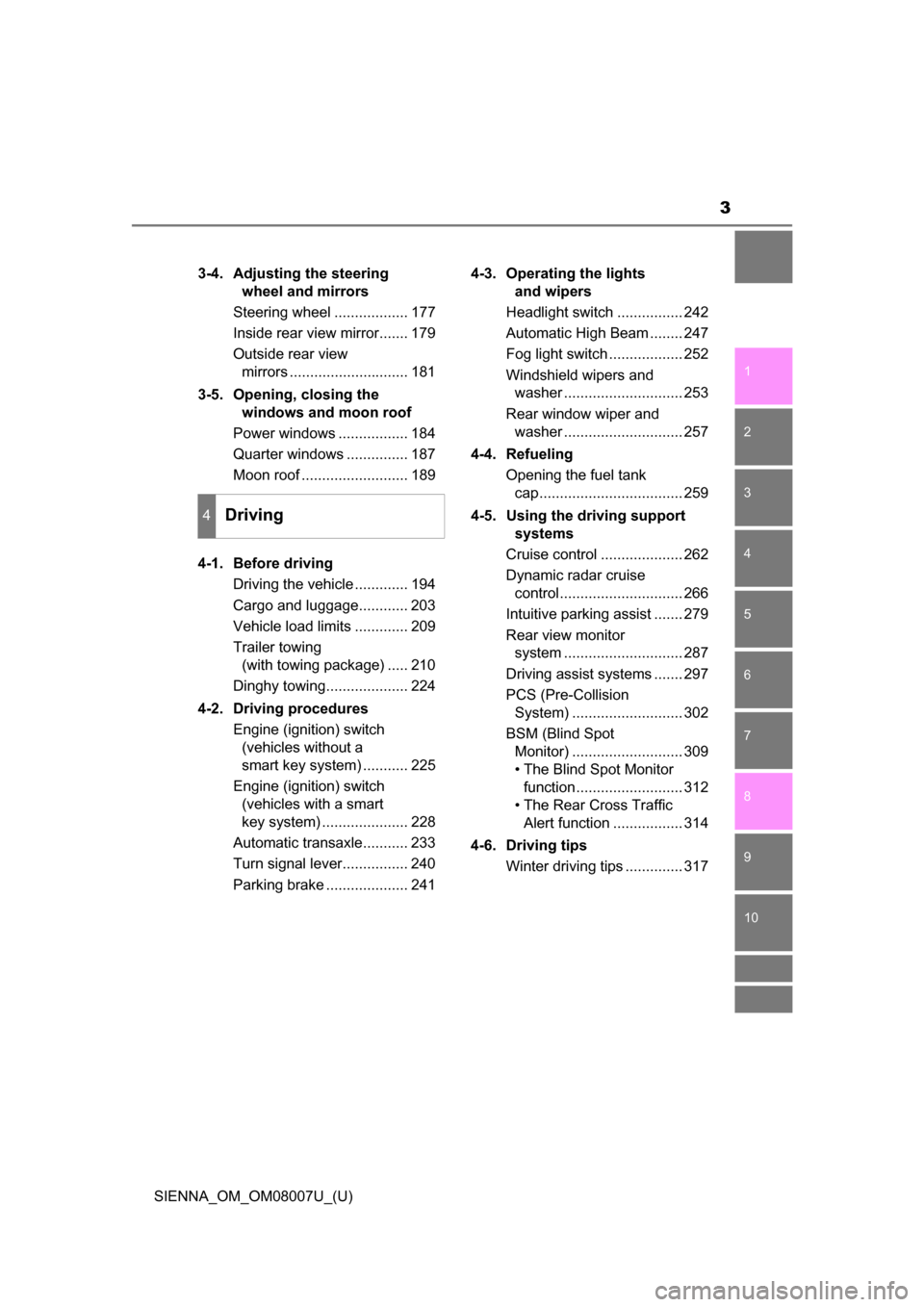
3
1
9 8
7
6 4 3
2
SIENNA_OM_OM08007U_(U)
10
5
3-4. Adjusting the steering wheel and mirrors
Steering wheel .................. 177
Inside rear view mirror....... 179
Outside rear view mirrors ............................. 181
3-5. Opening, closing the windows and moon roof
Power windows ................. 184
Quarter windows ............... 187
Moon roof .......................... 189
4-1. Before driving Driving the vehicle ............. 194
Cargo and luggage............ 203
Vehicle load limits ............. 209
Trailer towing (with towing package) ..... 210
Dinghy towing.................... 224
4-2. Driving procedures Engine (ignition) switch (vehicles without a
smart key system) ........... 225
Engine (ignition) switch (vehicles with a smart
key system) ..................... 228
Automatic transaxle........... 233
Turn signal lever................ 240
Parking brake .................... 241 4-3. Operating the lights
and wipers
Headlight switch ................ 242
Automatic High Beam ........ 247
Fog light switch .................. 252
Windshield wipers and washer ............................. 253
Rear window wiper and washer ............................. 257
4-4. Refueling Opening the fuel tank cap................................... 259
4-5. Using the driving support systems
Cruise control .................... 262
Dynamic radar cruise control.............................. 266
Intuitive parking assist ....... 279
Rear view monitor system ............................. 287
Driving assist systems ....... 297
PCS (Pre-Collision System) ........................... 302
BSM (Blind Spot Monitor) ........................... 309
• The Blind Spot Monitor function.......................... 312
• The Rear Cross Traffic Alert function ................. 314
4-6. Driving tips Winter driving tips .............. 317
4Driving
Page 15 of 672
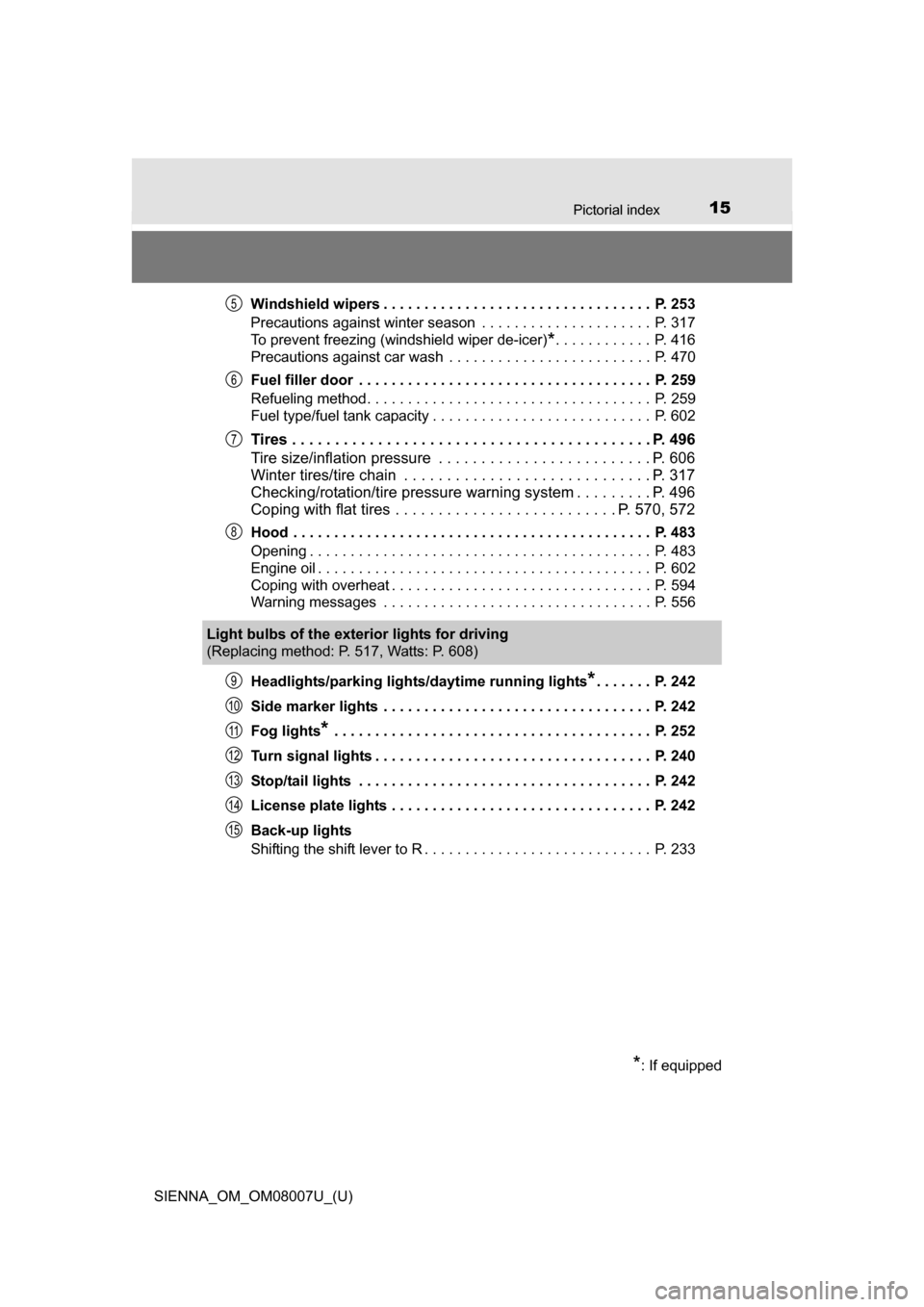
15Pictorial index
SIENNA_OM_OM08007U_(U)Windshield wipers . . . . . . . . . . . . . . . . . . . . . . . . . . . . . . . . . P. 253
Precautions against winter season . . . . . . . . . . . . . . . . . . . . . P. 317
To prevent freezing (windshield wiper de-icer)
*. . . . . . . . . . . . P. 416
Precautions against car wash . . . . . . . . . . . . . . . . . . . . . . . . . P. 470
Fuel filler door . . . . . . . . . . . . . . . . . . . . . . . . . . . . . . . . . . . . P. 259
Refueling method. . . . . . . . . . . . . . . . . . . . . . . . . . . . . . . . . . . P. 259
Fuel type/fuel tank capacity . . . . . . . . . . . . . . . . . . . . . . . . . . . P. 602
Tires . . . . . . . . . . . . . . . . . . . . . . . . . . . . . . . . . . . . . . . . . . P. 496
Tire size/inflation pressure . . . . . . . . . . . . . . . . . . . . . . . . . P. 606
Winter tires/tire chain . . . . . . . . . . . . . . . . . . . . . . . . . . . . . P. 317
Checking/rotation/tire pressure warning system . . . . . . . . . P. 496
Coping with flat tires . . . . . . . . . . . . . . . . . . . . . . . . . . P. 570, 572
Hood . . . . . . . . . . . . . . . . . . . . . . . . . . . . . . . . . . . . . . . . . . . . P. 483
Opening . . . . . . . . . . . . . . . . . . . . . . . . . . . . . . . . . . . . . . . . . . P. 483
Engine oil . . . . . . . . . . . . . . . . . . . . . . . . . . . . . . . . . . . . . . . . . P. 602
Coping with overheat . . . . . . . . . . . . . . . . . . . . . . . . . . . . . . . . P. 594
Warning messages . . . . . . . . . . . . . . . . . . . . . . . . . . . . . . . . . P. 556
Headlights/parking lights/ daytime running lights
*. . . . . . . P. 242
Side marker lights . . . . . . . . . . . . . . . . . . . . . . . . . . . . . . . . . P. 242
Fog lights
* . . . . . . . . . . . . . . . . . . . . . . . . . . . . . . . . . . . . . . . P. 252
Turn signal lights . . . . . . . . . . . . . . . . . . . . . . . . . . . . . . . . . . P. 240
Stop/tail lights . . . . . . . . . . . . . . . . . . . . . . . . . . . . . . . . . . . . P. 242
License plate lights . . . . . . . . . . . . . . . . . . . . . . . . . . . . . . . . P. 242
Back-up lights
Shifting the shift lever to R . . . . . . . . . . . . . . . . . . . . . . . . . . . . P. 233
5
6
7
8
Light bulbs of the exterior lights for driving
(Replacing method: P. 517, Watts: P. 608)
*: If equipped
9
10
11
12
13
14
15
Page 193 of 672
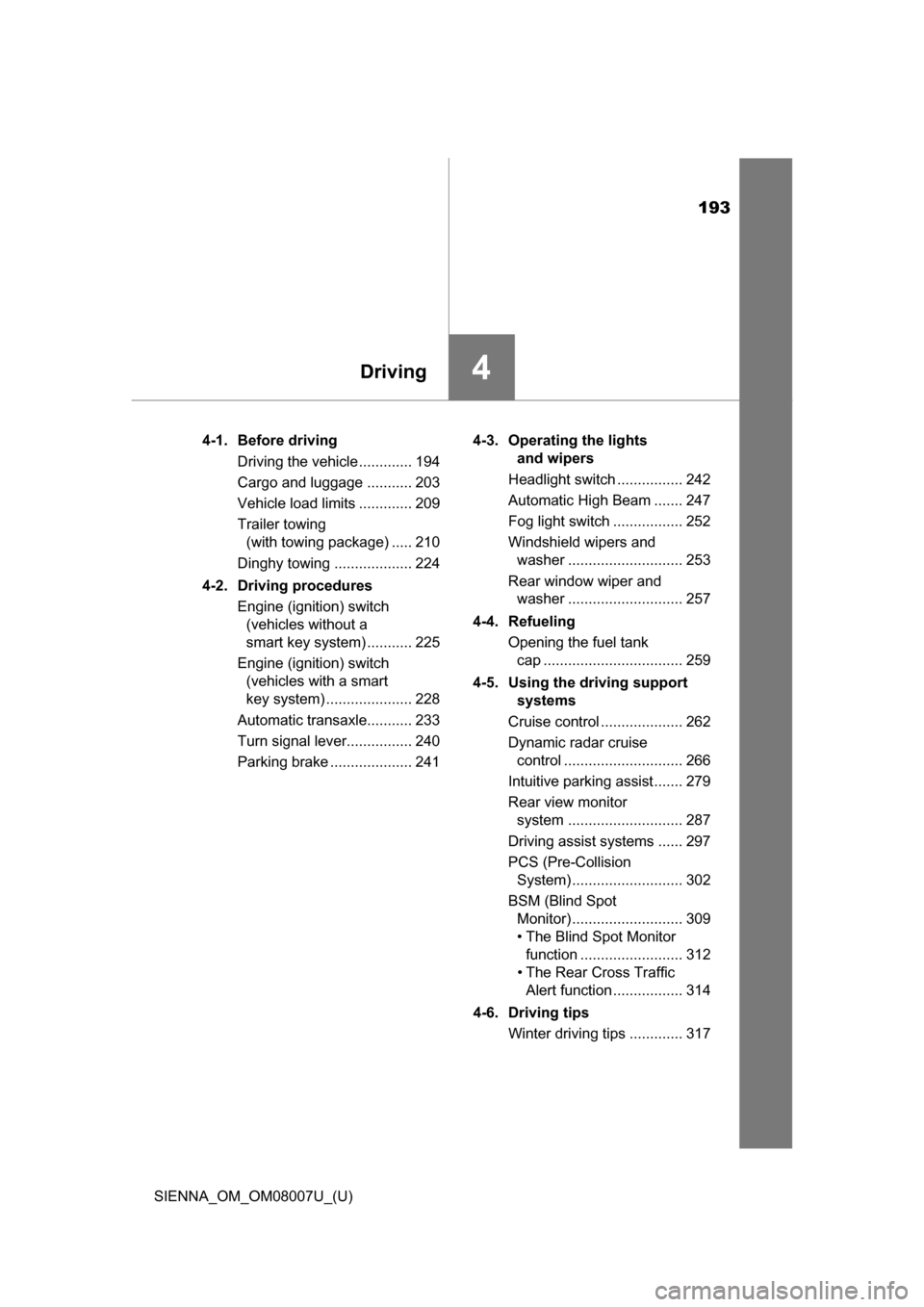
193
SIENNA_OM_OM08007U_(U)
4Driving
4-1. Before drivingDriving the vehicle ............. 194
Cargo and luggage ........... 203
Vehicle load limits ............. 209
Trailer towing (with towing package) ..... 210
Dinghy towing ................... 224
4-2. Driving procedures Engine (ignition) switch (vehicles without a
smart key system) ........... 225
Engine (ignition) switch (vehicles with a smart
key system) ..................... 228
Automatic transaxle........... 233
Turn signal lever................ 240
Parking brake .................... 241 4-3. Operating the lights
and wipers
Headlight switch ................ 242
Automatic High Beam ....... 247
Fog light switch ................. 252
Windshield wipers and washer ............................ 253
Rear window wiper and washer ............................ 257
4-4. Refueling Opening the fuel tank cap .................................. 259
4-5. Using the driving support systems
Cruise control .................... 262
Dynamic radar cruise control ............................. 266
Intuitive parking assist....... 279
Rear view monitor system ............................ 287
Driving assist systems ...... 297
PCS (Pre-Collision System) ........................... 302
BSM (Blind Spot Monitor) ........................... 309
• T he Blind Spot Monitor
function ......................... 312
• The Rear Cross Traffic Alert function ................. 314
4-6. Driving tips Winter driving tips ............. 317
Page 259 of 672
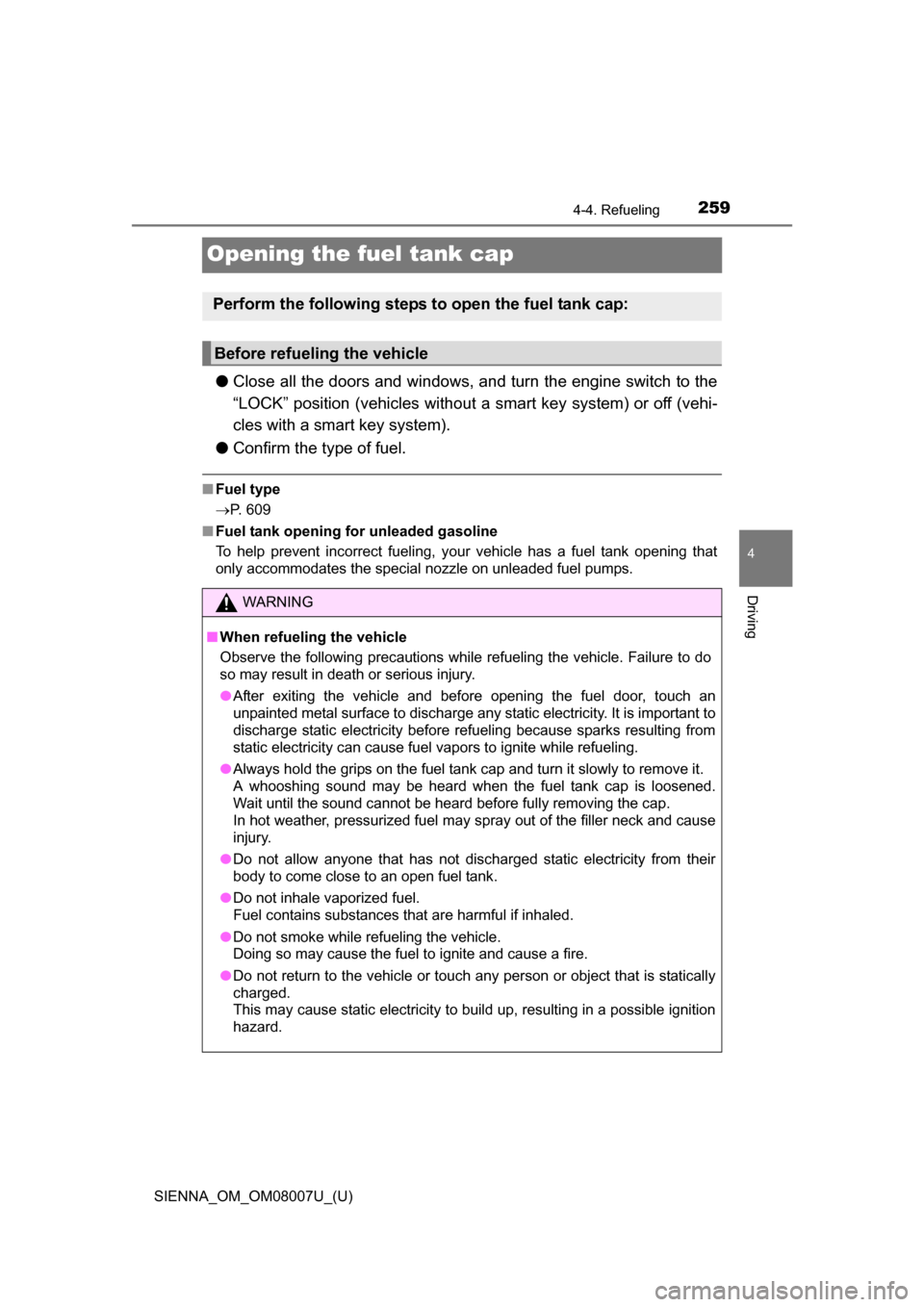
259
SIENNA_OM_OM08007U_(U)
4-4. Refueling
4
Driving
Opening the fuel tank cap
●Close all the doors and windows, and turn the engine switch to the
“LOCK” position (vehicles without a smart key system) or off (vehi-
cles with a smart key system).
● Confirm the type of fuel.
■Fuel type
P. 609
■ Fuel tank opening for unleaded gasoline
To help prevent incorrect fueling, your vehicle has a fuel tank opening that
only accommodates the special nozzle on unleaded fuel pumps.
Perform the following steps to open the fuel tank cap:
Before refueling the vehicle
WARNING
■When refueling the vehicle
Observe the following precautions while refueling the vehicle. Failure to do
so may result in death or serious injury.
●After exiting the vehicle and before opening the fuel door, touch an
unpainted metal surface to discharge any static electricity. It is important to
discharge static electricity before refueling because sparks resulting from
static electricity can cause fuel vapors to ignite while refueling.
● Always hold the grips on the fuel tank cap and turn it slowly to remove it.
A whooshing sound may be heard when the fuel tank cap is loosened.
Wait until the sound cannot be heard before fully removing the cap.
In hot weather, pressurized fuel may spray out of the filler neck and cause
injury.
● Do not allow anyone that has not discharged static electricity from their
body to come close to an open fuel tank.
● Do not inhale vaporized fuel.
Fuel contains substances that are harmful if inhaled.
● Do not smoke while refueling the vehicle.
Doing so may cause the fuel to ignite and cause a fire.
● Do not return to the vehicle or touch any person or object that is statically
charged.
This may cause static electricity to build up, resulting in a possible ignition
hazard.
Page 260 of 672
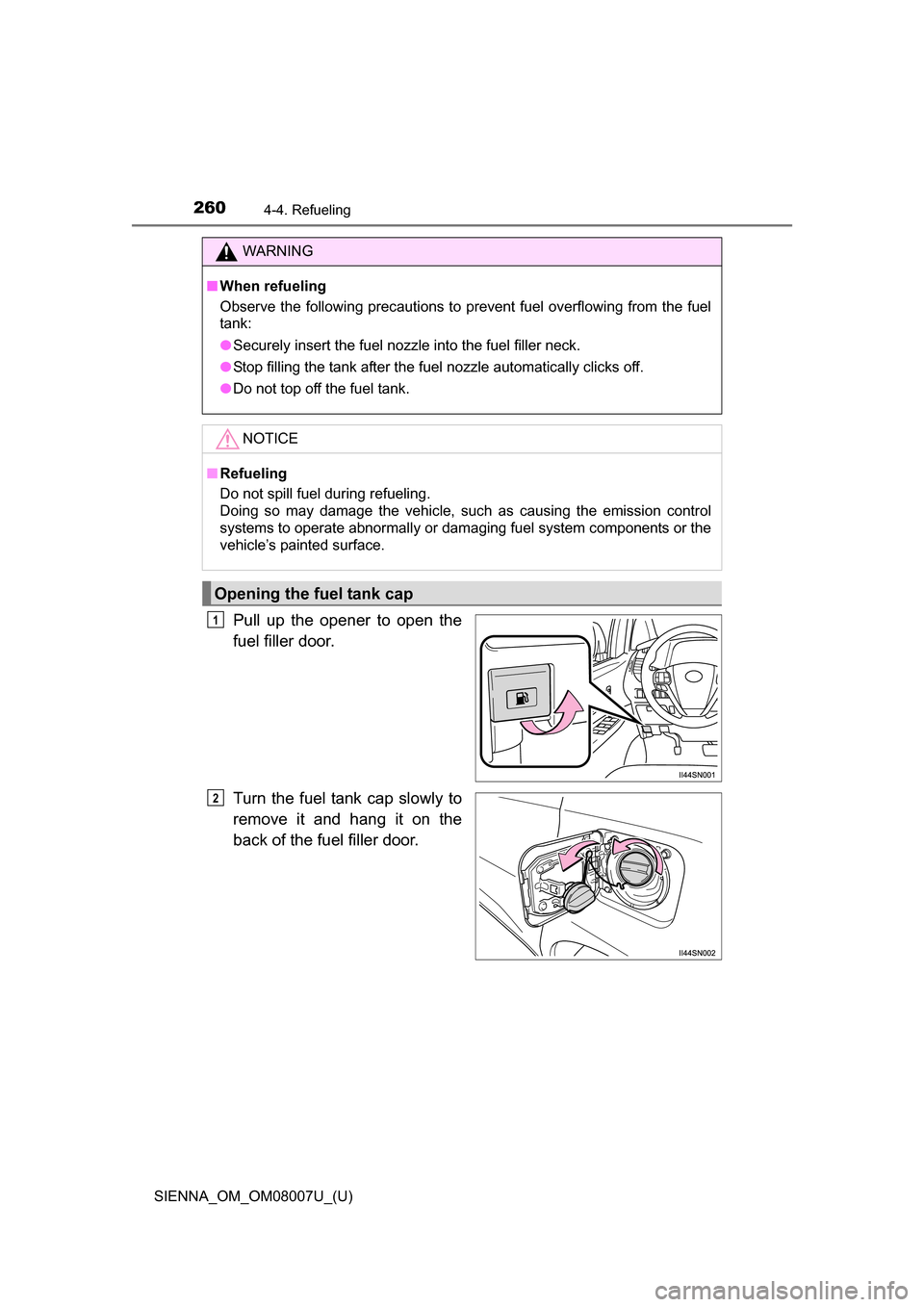
260
SIENNA_OM_OM08007U_(U)
4-4. Refueling
Pull up the opener to open the
fuel filler door.
Turn the fuel tank cap slowly to
remove it and hang it on the
back of the fuel filler door.
WARNING
■When refueling
Observe the following precautions to prevent fuel overflowing from the fuel
tank:
●Securely insert the fuel nozzle into the fuel filler neck.
● Stop filling the tank after the fuel nozzle automatically clicks off.
● Do not top off the fuel tank.
NOTICE
■Refueling
Do not spill fuel during refueling.
Doing so may damage the vehicle, such as causing the emission control
systems to operate abnormally or damaging fuel system components or the
vehicle’s painted surface.
Opening the fuel tank cap
1
2
Page 261 of 672

SIENNA_OM_OM08007U_(U)
2614-4. Refueling
4
Driving
After refueling, turn the fuel tank
cap until you hear a click. Once
the cap is released, it will turn
slightly in the opposite direction.
Closing the fuel tank cap
WARNING
■When replacing the fuel tank cap
Do not use anything but a genuine Toyota fuel tank cap designed for your
vehicle. Doing so may cause a fire or other incident which may result in
death or serious injury.
Page 480 of 672
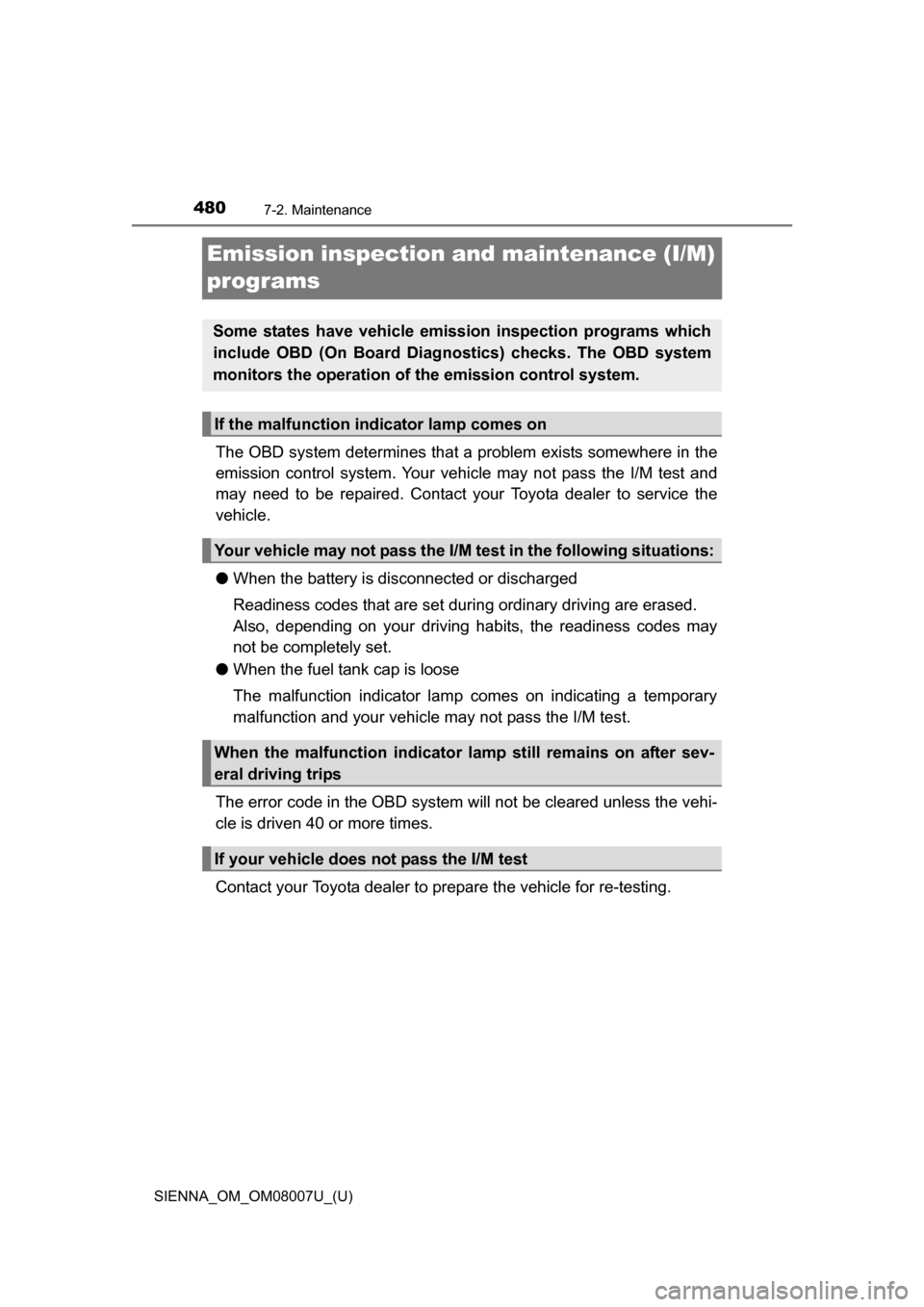
480
SIENNA_OM_OM08007U_(U)
7-2. Maintenance
Emission inspection and maintenance (I/M)
programs
The OBD system determines that a problem exists somewhere in the
emission control system. Your vehicl e may not pass the I/M test and
may need to be repaired. Contact your Toyota dealer to service the
vehicle.
● When the battery is disconnected or discharged
Readiness codes that are set duri ng ordinary driving are erased.
Also, depending on your driving habits, the readiness codes may
not be completely set.
● When the fuel tank cap is loose
The malfunction indicator lamp comes on indicating a temporary
malfunction and your vehicle may not pass the I/M test.
The error code in the OBD system will not be cleared unless the vehi-
cle is driven 40 or more times.
Contact your Toyota dealer to prepare the vehicle for re-testing.
Some states have vehicle emission inspection programs which
include OBD (On Board Diagnos tics) checks. The OBD system
monitors the operation of the emission control system.
If the malfunction indicator lamp comes on
Your vehicle may not pass the I/M test in the following situations:
When the malfunction indicator lamp still remains on after sev-
eral driving trips
If your vehicle does not pass the I/M test
Page 505 of 672
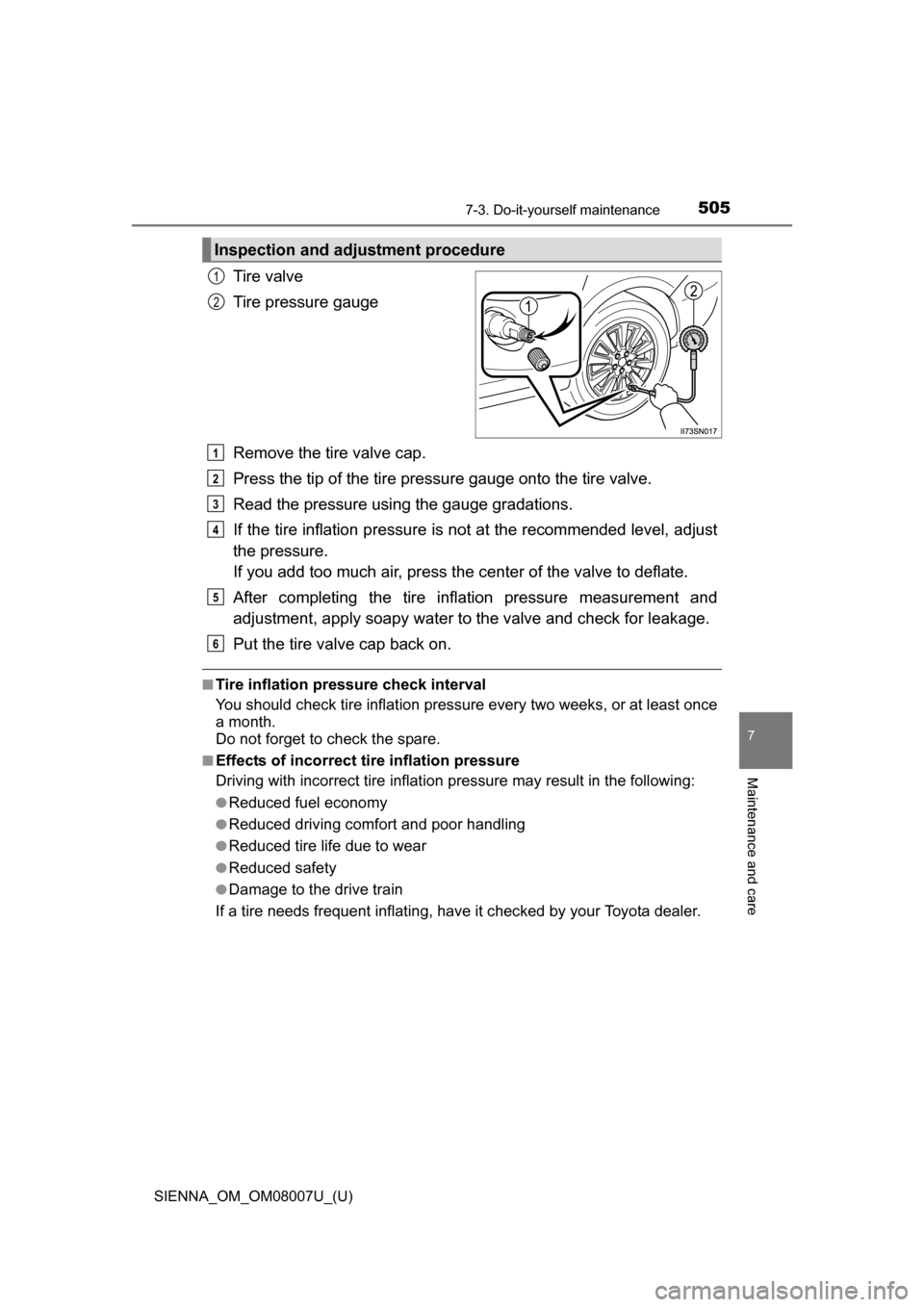
SIENNA_OM_OM08007U_(U)
5057-3. Do-it-yourself maintenance
7
Maintenance and care
Tire valve
Tire pressure gauge
Remove the tire valve cap.
Press the tip of the tire pressure gauge onto the tire valve.
Read the pressure usi ng the gauge gradations.
If the tire inflation pressure is not at the recommended level, adjust
the pressure.
If you add too much air, press the center of the valve to deflate.
After completing the tire inflation pressure measurement and
adjustment, apply soapy water to the valve and check for leakage.
Put the tire valve cap back on.
■Tire inflation pressure check interval
You should check tire inflation pressure every two weeks, or at least once
a month.
Do not forget to check the spare.
■Effects of incorrect tire inflation pressure
Driving with incorrect tire inflation pressure may result in the following:
●Reduced fuel economy
●Reduced driving comfort and poor handling
●Reduced tire life due to wear
●Reduced safety
●Damage to the drive train
If a tire needs frequent inflating, have it checked by your Toyota dealer.
Inspection and adjustment procedure
1
2
1
2
3
4
5
6